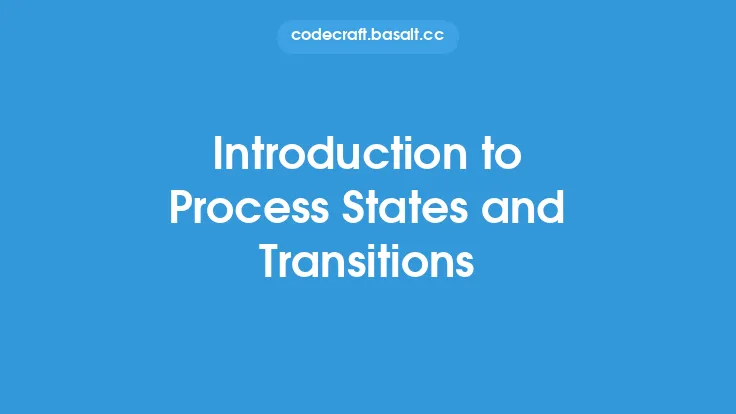Process creation and termination are fundamental concepts in operating systems, as they enable the execution and management of programs on a computer. When a program is executed, the operating system creates a new process, which is an independent entity that runs concurrently with other processes. In this article, we will delve into the details of process creation and termination, exploring the underlying mechanisms, data structures, and system calls involved.
Introduction to Process Creation
Process creation involves the operating system allocating resources, such as memory and CPU time, to a new process. This process is initiated when a program is executed, either by a user or by another process. The operating system creates a new process by performing the following steps:
- Process ID allocation: The operating system allocates a unique process ID (PID) to the new process.
- Memory allocation: The operating system allocates memory to the new process, including the program code, data, and stack.
- Context creation: The operating system creates a new context for the process, which includes the program counter, registers, and other state information.
- Resource allocation: The operating system allocates resources, such as file descriptors and sockets, to the new process.
The operating system uses system calls, such as `fork()` and `exec()`, to create a new process. The `fork()` system call creates a new process by duplicating an existing process, while the `exec()` system call replaces the program code of a process with a new program.
Process Termination
Process termination occurs when a process completes its execution or is terminated by the operating system. A process can terminate in several ways, including:
- Normal termination: A process can terminate normally by completing its execution and returning control to the operating system.
- Error termination: A process can terminate due to an error, such as a division by zero or an invalid memory access.
- Signal termination: A process can terminate due to a signal, such as a SIGKILL or SIGTERM signal, sent by the operating system or another process.
- Resource exhaustion: A process can terminate due to resource exhaustion, such as running out of memory or CPU time.
When a process terminates, the operating system performs the following steps:
- Resource deallocation: The operating system deallocates resources, such as memory and file descriptors, allocated to the process.
- Context destruction: The operating system destroys the context of the process, including the program counter, registers, and other state information.
- PID deallocation: The operating system deallocates the PID allocated to the process.
The operating system uses system calls, such as `exit()` and `wait()`, to terminate a process. The `exit()` system call terminates a process and returns control to the operating system, while the `wait()` system call allows a parent process to wait for the termination of a child process.
Process Creation and Termination System Calls
The operating system provides several system calls to create and terminate processes. Some of the commonly used system calls include:
- `fork()`: Creates a new process by duplicating an existing process.
- `exec()`: Replaces the program code of a process with a new program.
- `exit()`: Terminates a process and returns control to the operating system.
- `wait()`: Allows a parent process to wait for the termination of a child process.
- `kill()`: Sends a signal to a process, which can terminate the process.
- `signal()`: Allows a process to catch and handle signals sent by the operating system or other processes.
These system calls provide a way for processes to interact with the operating system and manage their execution.
Process Data Structures
The operating system uses several data structures to manage processes, including:
- Process Control Block (PCB): A data structure that contains information about a process, such as its PID, program counter, and registers.
- Process table: A data structure that contains a list of all processes in the system, including their PIDs and states.
- Memory map: A data structure that maps the virtual memory of a process to physical memory.
These data structures provide a way for the operating system to manage processes and allocate resources efficiently.
Conclusion
In conclusion, process creation and termination are essential concepts in operating systems, enabling the execution and management of programs on a computer. The operating system uses system calls, such as `fork()` and `exec()`, to create new processes, and system calls, such as `exit()` and `wait()`, to terminate processes. The operating system also uses data structures, such as the process control block and process table, to manage processes and allocate resources efficiently. Understanding process creation and termination is crucial for developing efficient and effective operating systems.





